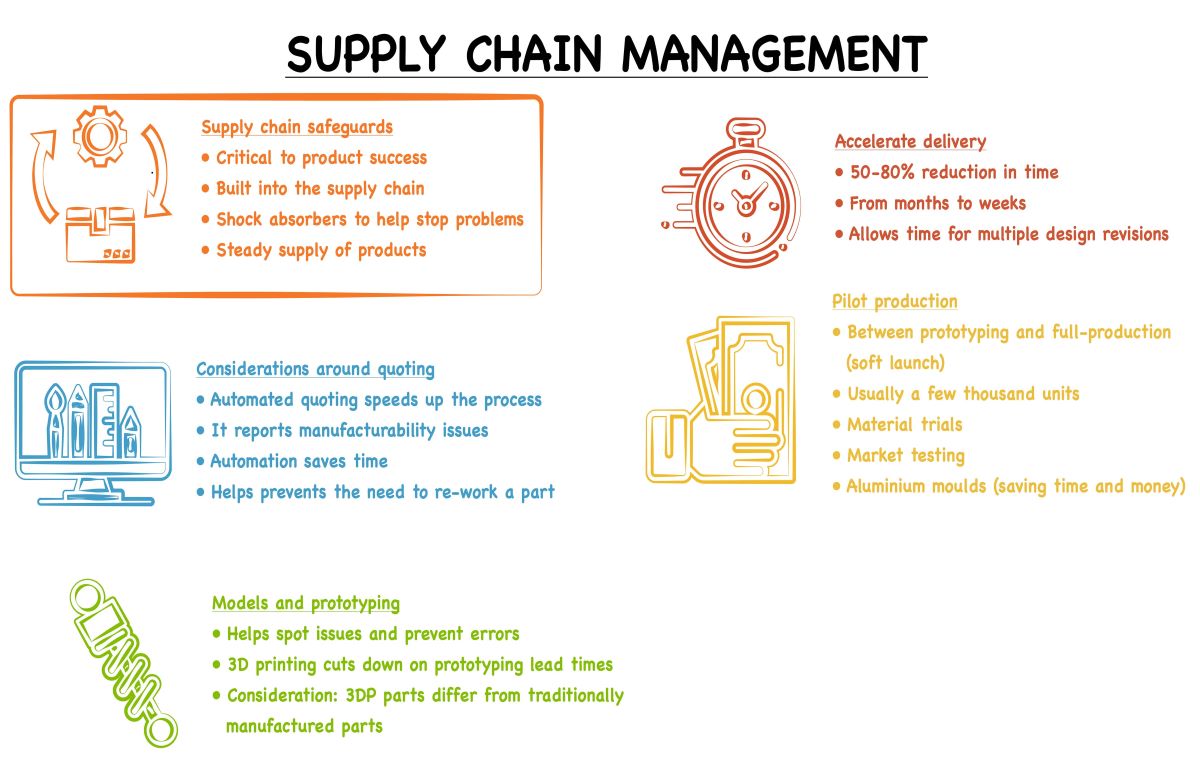
Supply Chain Management
Your masterclass in product design and development
Protolabs’ Insight video series
Our Insight video series will help you master digital manufacturing.
Every Friday we’ll post a new video – each one giving you a deeper Insight into how to design better parts. We’ll cover specific topics such as choosing the right 3D printing material, optimising your design for CNC machining, surface finishes for moulded parts, and much more besides.
So join us and don’t miss out.
Insight: Supply Chain Management
Transcript
Hello and welcome to this week’s Insight.
If you’ve been keeping up with these videos for some time, you’ll know that I usually talk about the more technical aspects of manufacturing. Today, however, we’re changing things up a bit with a piece about reducing risk through on-demand manufacturing.
This is a critical component of product development and life cycle planning, and one that can play just as big a role in the product’s success as the right choice of material or proper placement of an injection gate.
It’s quite a big subject, so today we’re probably going to stick to a quick discussion about supply chain safeguards and how they apply in regard to manufacturing.
First up, let’s talk about what we mean by supply chain safeguards.

These are essentially things we build into our manufacturing supply chain that will prevent disruptions or enable recovery from any challenges that do pop up. Think of them as shock absorbers that help to stop problems from cascading downstream through our product development process. Clever use of safeguards should ensure a steady supply of product in line with your target delivery dates.
Okay, so this is great in theory, but let’s take a look at a handful of practical examples of manufacturing safeguards.

Let’s start by considering the quoting process, which can potentially cause weeks or even months of delay as you and the manufacturer send messages back and forth, especially if you’re dealing with multiple parts for a single assembly.
By making use of specialist software and automated manufacturing equipment, however, interactive online quotes with manufacturability analysis can be available within hours of your submission.
These sophisticated online quoting programs can report and illustrate design issues that can impact quality, cost, and time to market, saving you days, even weeks, over the length of a project. More than this, early feedback can help to reduce that chance you need to rework a part you already thought finished.
It may not seem like it at first glance, but that’s a prime example of a manufacturing safeguard.

Another potentially time-consuming part of the development process is creating the models and prototypes you need for form, fit and functional testing. These are vital tools in spotting flaws with your product before investing in full production, but they can also slow things down pretty significantly. Sometimes, making these one-off or short-run products can take weeks, and if you need several over the course of development… well, you can see where I’m going.
Again, though, this is somewhere that tech can help out. 3D printing can allow you to dramatically cut down on lead times, with research suggesting reductions of fifty to eighty percent over conventional manufacturing.
The downside to this is that 3D printing does produce parts that have somewhat different physical characteristics and design constraints than those parts made using traditional manufacturing processes. Fortunately, there are some suppliers that specialise in rapid conventional manufacturing, and should be able to reduce the lead time down from months to less than a fortnight.

This kind of accelerated delivery offers a responsiveness that allows execution of multiple design revisions to fine tune product designs for quality, performance and manufacturing costs, while helping to prevent the chances of any re-designs or re-works further down the line.

Another example of a manufacturing safeguard comes in the form of pilot production, which falls somewhere between prototyping and full production. Some people refer to it as a “soft launch” and production will usually consist of only a few thousand units.
This may seem like it would only help to slow things down even more, but this kind of pilot production can provide material that you can use for trials, evaluations and test marketing.
Of course, if this is going to help it needs to be handled carefully. While it would be ideal to match all the characteristics of your final production process with your pilot programme, it’s often okay to just go with close approximations - CNC machining or 3D printing for parts that will ultimately be injection moulded, for example.
Another alternative is to simplify the production process. If, for example, parts will be injection moulded, you could substitute steel moulds for aluminium ones, saving you plenty of money and time.
If used wisely, this can help you defer the investment in production equipment, while accelerating the delivery of production-grade products. This allows a thorough analysis prior to investing in capital or operational assets that may be challenging and expensive to adjust, modify or replace.
We’re running out of time now, but those few examples should hopefully show that manufacturing safeguards can help to prevent disruptions to the entire production process and are something well worth thinking about.
That’s it for this week. I look forward to seeing you again next Friday.
With special thanks to Natalie Constable.







